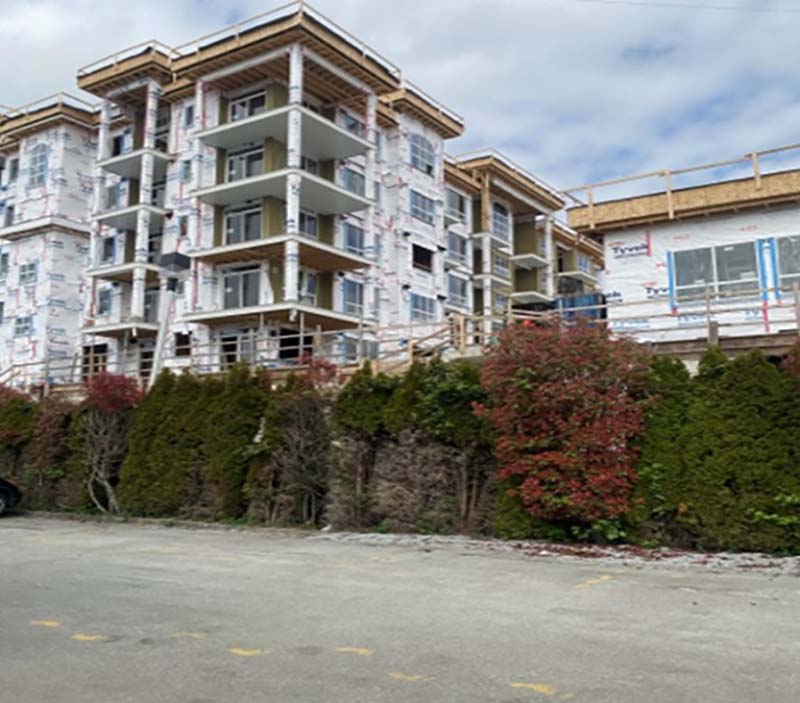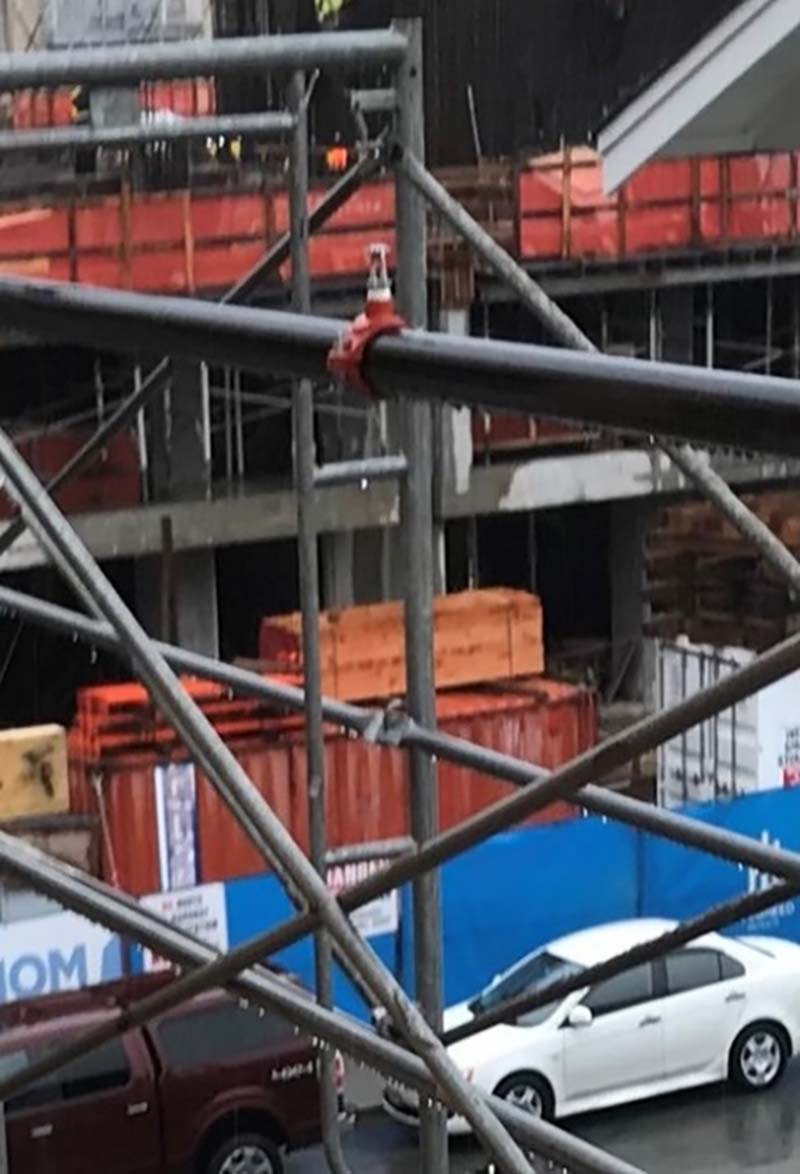By JOHN A. MACDONALD
One of the most dangerous phases in building construction is during what is referred to as the “prelockup” stage. During this part of building construction, foundations and footings are laid, and the building moves upward floor by floor. In Type 5 construction that uses wood, this presents tremendous challenges for firefighters.
Green Building Challenges for the Fire Service
Imagine hundreds of cubic feet of wood essentially stacked 40 to 80 feet in the air, a situation in which the “fire triangle” is perfectly completed, given the right circumstances. Heat, fuel, and oxygen combine to create an inferno, essentially a massive bonfire that is beyond the means or control of any fire department. These high-risk circumstances are the reality facing 21st-century fire departments as they grapple with an issue that is as old as wood-frame construction itself.
When the perfect conditions exist, time is not on our side, and risk reduction is often our best ally. How can we become more progressive to allay the dangers that exist as buildings go up? This article will examine the three phases of construction; put forth viable strategies for incident command; and look at risk-reduction measures that may, in the long run, be the real answer to controlling these fires.
A New Reality
Building green and using sustainable products have become common terminology in building design for wood-frame construction. These types of structures seem to have a secure future. New technology along with improved building and fire codes is a new reality for Type 5 construction, and engineers want to make them bigger and build them higher. The wood high-rise once considered a pipe dream is now reality, and the concept is gaining popularity. As these buildings go up, fire departments must understand the challenges presented to them.

(1) The “open phase”: The building has multiple openings and no fire protection in place save for interior standpipes that may be in place in stairwells. (Photos by author.)

(2) The “lockup phase”: Exterior windows and doors are in place. The construction finishing phase begins on the interior, with floors being finished from the top down.

(3) Building envelopes are common where exterior finishing like brickwork may go into place. These impediments can make quick attack with exterior hoselines more difficult.
During what I call the “open phase” of construction, the building is essentially stacked pallets of wood reinforced with supporting members or interior concrete shafts for things like elevators; this is prelockup, when windows and doors and fire separations are not yet in place. Any fire that takes hold in one of these structures is extremely dangerous for firefighters and must be considered to have an extremely high-risk profile. The window for initial attack must be swift, and the reach of stream must be used. Prefire planning is essential to assist with a quick attack. Officers and crews must know where water supply is located, and apparatus must be positioned for maximum flow with master streams while respecting structural collapse, exposures, and radiant heat potential.
As Type 5 buildings go up, code requirements must include standpipe connections on each floor. These systems are tenuous at best; they may tempt fire companies to go interior when risk assessment indicates otherwise. There is no “silver bullet” as to when to go defensive or offensive, but knowing the area and using reach of stream may be a better strategy that will ensure firefighters go home at the end of the event.
During the lockup phase, windows, doors, and fire separations are now in place. This can limit fire growth initially, but it can also conceal smoke conditions, making it more difficult for firefighters to determine fire location. Reach of stream and defensive firefighting may also be thwarted as the construction moves forward and the building begins to take shape, limiting the effects of exterior operations. Windows and doors that keep weather elements out of the building under construction now inhibit our ability to reach the fire in either a defensive or an offensive operation.

(4) The “finished phase”: The building is ready for occupancy. Fire protection systems and fire separations are in place.
Again, the risk must be worth the reward, and command will be faced with tough decisions. In this instance, interior standpipes may be viable, but they must be used in a timely manner. Teams must move quickly, and egress routes must be maintained.
The window for attack may be no more than 20 minutes from the initial ignition, and conditions will quickly deteriorate if water is not applied to the fire in an expedient manner. It is also critical that, when fire crews or attack teams enter the structure, they stay together and remain in constant voice and visual contact. Hoselines provide the ultimate direction for escape and retreat with the nozzle forward, ensuring the protection of team members. When conditions warrant it, teams must be ready to quickly withdraw from or abandon the structure. Again, we must use extreme caution when we go interior. No vacant building is worth the life of a firefighter.

(5) Exterior scaffolding with a sprinkler attachment for adjacent building protection.
During the final phase of construction, the building fire protection systems are in place and the building has been compartmentalized into the spaces that will make up the building units. These passive (separations, floors, walls) and active systems (standpipes, alarms, sprinklers) are present during the “occupancy phase” and, depending on the stage of the occupancy, there may be more fire load added to the building as occupant belongings and furniture take up the space within the structure. In this situation, incident commanders (ICs) may feel more comfortable as we begin to fight fire on a more level playing field yet recognize the hazards of lightweight wood-frame construction including rapid void space fire spread and failure of lightweight structural members. The building is familiar to us, and the systems (standpipes, annunciator panels, fire doors, sprinklers, smoke alarms) are in place to assist us.
Every day, firefighters battle fire conditions in completed buildings; for the most part, we are quite successful with knocking fires down that do not extend to the exterior or enter the roof space. For the most part, the risk profile may present a worthwhile option for aggressive interior attack. Constant monitoring and feedback to command from interior and exterior crews are essential to maintain safety of all members on the fireground. If conditions begin to change dramatically and the fire begins to gain the upper hand, it may be best to withdraw from the structure and moving to a defensive posture to ensure firefighter safety.
The IC will be faced with difficult decisions during all three phases of construction that involve fire. Command must rely on feedback from officers and trust their experience and knowledge. When in doubt, where the risk seems too high, play it safe, and stabilize the scene to the best of your ability; the building might not be savable.

(6) Water curtains by way of scaffolding with sprinkler heads and piping attached can be put in place to protect adjacent buildings that are occupied or under construction.

(7) Area familiarization and walk-throughs of buildings under construction must be completed regularly during the construction phase. These can help facilitate the quick action needed when fire strikes these vulnerable structures.
Apartment fires are extremely difficult to fight, requiring tremendous resources. Given the phase of construction, we recognize the formidable task that we potentially could be facing. It’s something that is impossible to completely prepare for, but it is something we must face and discuss. The true answer to safeguard firefighter safety lies in risk reduction and improved prevention.
Risk reduction lies at the heart of limiting the impact fires ultimately have on large wood-frame structures that are under construction. It is critical to make constant security checks with increased frequency as the building becomes more compartmentalized. Walking through each floor every hour may not be enough, depending on the size of the structure. When size warrants it, double your efforts to check areas every 30 minutes; this gives firefighters more time to be alerted when a fire takes place.
Another active, preventive measure is prebuilt scaffold water curtains to protect adjacent structures from the radiant heat caused by fire in buildings under construction. Often, adjacent buildings catch fire as the heat melts siding and soffits and enters voids or building entry points. On many occasions, adjacent buildings that are occupied have caught fire because of radiant heat or ember travel—collateral damage from the initial fire. Sprinklers connected to standpipes can perform better than master streams when acting as a water curtain as they work to control the fire. The small droplets created absorb more heat and help better protect adjacent structures, and they allow firefighters to focus water streams on the building, which is critical to controlling the peak release rate of the fire.
Protecting adjacent structures involves prefire planning and organization, but the effort is worth it if fire strikes the building under construction. Fire losses will be lessened and the life safety for residents in adjacent buildings is improved if adjacent buildings have the following:
- Smoke alarms.
- Increased security.
- Prebuilt water curtains.
- Mandatory walk-throughs for fire crews and regular building updates and fire crew visits through all stages of construction.
National Fire Protection Association (NFPA) 1300, Standard on Community Risk Assessment and Community Risk Reduction Plan Development, outlines community risk assessment and, given the destructive potential of these large buildings under construction, pays special attention to ways of addressing the danger through better strategies and policies. The fire department can play a key leadership role in maintaining and safeguarding the community through progressive measures that address this risk. Only by being proactive and truly understanding community risk reduction in the face of a tremendous fire hazard can we move forward and address our future role in keeping our firefighters and the community safe from these destructive fire events.
Author’s note: Special thanks to Randy Minaker, technical contributor, deputy chief of the Port Coquitlam (British Columbia, Canada) Fire and Emergency Services, protective services member, public educator, local assistant to the fire commissioner, and NFPA 1730 technical committee member since 2012.
References
Garis L and J Clare. “Construction Site Fire Response Preventing and Suppressing Fires During Construction of Large Buildings.” (March 2015). Centre for Public Safety and Criminal Justice Research, School of Criminology and Criminal Justice, University of the Fraser Valley.
Campbell R. “Fire in Structures under Construction or Renovation.” (February 2020). Retrieved from: www.nfpa.org//-/media/Files/News-and-Research/Fire-statistics-and-reports/Building-and-life-safety/osFiresInStructuresUnderConstruction.pdf.
Langois, C. “The First Arriving Engine at Externally Ignited Apartment Fires.” Fire Engineering, March 2018. Retrieved from: emberly.fireengineering.com/firefighting/the-first-arriving-engine-at-externally-ignited-apartment-building-fires/.
O’Brocki, R. “Pre-planning and Suppression of Buildings under Construction.” American Wood Council (2017). Retrieved from; https://www.awc.org/pdf/education/bcd/AWC-BCD232-PrePlanningAndSuppression-181211.pdf.
JOHN A. MACDONALD is a 29-year fire service veteran and a deputy chief of operations with Port Coquitlam (British Columbia, Canada) Fire and Emergency Services. He has worked in all fire service capacities, from firefighter to company officer. He has a master’s degree in emergency management and has authored several articles for Fire Engineering.

